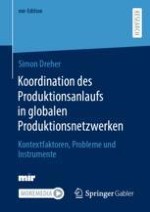2024 | OriginalPaper | Buchkapitel
4. Empirische Untersuchung bedeutsamer Koordinationsprobleme und -instrumente unter Berücksichtigung unterschiedlicher Konfigurationstypen globaler Produktionsnetzwerke
verfasst von : Simon Dreher
Erschienen in: Koordination des Produktionsanlaufs in globalen Produktionsnetzwerken
Verlag: Springer Fachmedien Wiesbaden
Aktivieren Sie unsere intelligente Suche, um passende Fachinhalte oder Patente zu finden.
Wählen Sie Textabschnitte aus um mit Künstlicher Intelligenz passenden Patente zu finden. powered by
Markieren Sie Textabschnitte, um KI-gestützt weitere passende Inhalte zu finden. powered by
